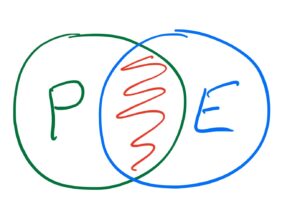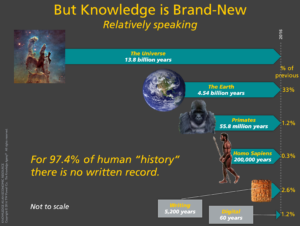
PARALLEL WORLDS 2: Connections – the P-E Nexus
We’ve been discussing the physical and the epistemic worlds — and their differences. But what about the Venn diagram overlap that connects them — the Physical-Epistemic Nexus?  Therein lie the most promising opportunities — and the most vexing challenges. While the newer connections are technology-powered, the older ones are embedded in our collective human DNA.
Therein lie the most promising opportunities — and the most vexing challenges. While the newer connections are technology-powered, the older ones are embedded in our collective human DNA.
Integrative technologies
Modern technologies explicitly mine the overlap between the two parallel worlds. Augmented reality technologies., for example, overlay information on visualizations of the real world. The virtual reality metaverse hosts digital avatars that explicitly stand in for their real-world counterparts.
I recall a TV ad several years ago for a health insurance company that featured realistic video of people walking around — with, superimposed over their images in real time, various metrics associated with their health. We’re increasingly aware of our many biological numbers, especially as real-time monitoring via smartwatches becomes accessible and reliable.
The internet of things movement that was buzzy a few years ago essentially meant embedding electronic sensors into other devices — kitchen appliances, industrial machines, and so on.
Much of what organizations do when they undertake enterprise digitization involves the transplanting of processes (or parts thereof) from P to E — when, for example, a physical bank teller becomes an ATM machine or even a DIY online banking experience.
‘Knowledge work’
The P-E Nexus is a fertile field in which to produce value. Much of the work of pre-digital knowledge workers consisted of manually (and laboriously) integrating the two worlds — as I described in my previous post. In my latest book, I describe the guiding-gatekeeping role that knowledge workers play with regard to the E-world.
The narrative envelope
The information about a product provides an essential element of the product’s value proposition. Every product, whether tangible or intangible, is sheathed within a wrapper of information that supports and amplifies it. This literally begins with its physical packaging — which conveys explicit signals, including the words on the outside (ingredients, instructions, etc.) — and implicit ones, like whether plastic or biodegradable cardboard is used.
Around that, we build a lot of other signaling that helps prospective owners of our product to become owners, and owners to become more effective users of the product. Much of marketing communications and advertising address this opportunity. Peer-to-peer information shared among networks and communities of customers helps them use your product more effectively and solve problems related to owning and using it.
I own and operate a small media production studio that I use for business and pleasure. I often purchase audio and video equipment that is expensive and requires a fair amount of skill to operate effectively. One of the primary things I consider in making such a purchase is the narrative around the product. Are specifications and test results available that give me an idea of how well the unit performs? Are there online videos to demonstrates the product’s features and usage? Is there an online community where people share reactions, problems, and solutions related to the product? What is the company’s history and reputation?
The physical underbelly of the epistemic
Even the ‘most epistemic’ representations embody essential physical aspects. Computer algorithms are stored in code, which is stored in chips and hard drives — physical devices that have useful lives, failure rates, power consumption demands, other resource needs like water to cool them, and so on. Even our proverbial Stone Age artist had a cave wall and some kind of pigment with which to depict physical reality.
And my mother’s beautiful butterfly trivet — which I intended to share with you — is safely stored away in one of my warehouse spaces, lost (temporarily) in the P-world.
Money
Money is an interesting case in that it bridges both worlds. Walter Wriston, who headed Citibank in the 1980s, said nearly three decades ago that “Information about money has become become nearly as important as money itself.” That was long before we had cryptocurrencies, a more obvious hybrid.
Money consists largely of symbols — balance entries in your account — that represent value in the physical world — you can buy actual goods and services with it.
The human connection
Each of the above is a ‘synthetic’ P-E connection — forged by us, for us. But there are also much deeper organic P-E connections baked into our cognitive DNA.
If you’ve seen Stanley Kubrick’s film 2001: A Space Odyssey, you’re unlikely to forget the iconic opening scene. An apocryphal hominid discovers that he can use a bone to kill his dinner and then attack a rival. Obviously convinced that this is a big deal, the alpha super-primate hurls the bone skyward — where it seamlessly morphs into a modern orbiting space station.
‘Mankind the toolmaker’ thus enters the evolutionary picture, on our way to making stone tools — then onward to eventually dominating all other species. Thanks to archaeological techniques like carbon dating, we’re able to place these watershed events of pre-human physical agency at around 2 1/2 million years ago.
Epistemic agency
But the evolution of epistemic agency — the ability to do things with information — does not yield to such dating techniques, as much of the E-world leaves little lasting physical record. Though speaking likely preceded writing by hundreds of millennia, it left no physical trace — until electronic recording was invented much later (in the late 19th century.)
 From prior to then, written words are all that survive. As far as we know, writing came on the scene around 3500 BCE — relatively recently in the 200,000-plus-year run of homo sapiens. The earliest known written language, cuneiform on clay tablets from Mesopotamia, are records of the physical world — inventory tallies of physical resources, including stored grain and (regrettably) slaves. Some of these dates are shown on this slide from one of my talks with Columbia graduate students.
From prior to then, written words are all that survive. As far as we know, writing came on the scene around 3500 BCE — relatively recently in the 200,000-plus-year run of homo sapiens. The earliest known written language, cuneiform on clay tablets from Mesopotamia, are records of the physical world — inventory tallies of physical resources, including stored grain and (regrettably) slaves. Some of these dates are shown on this slide from one of my talks with Columbia graduate students.
At some time much earlier than writing, humans learned to communicate with each other using socially-coordinated vocal sounds — grunting and proto-talking that gradually evolved into spoken language. Yuval Harari places this cognitive revolution around 70,000 years ago. This in turn enabled human entrainment — the ability to coordinate behaviors — an essential pillar of all human culture and civilization.
A primal bond
Once humans could speak, over millennia we miraculously developed ways of giving ‘names’ to ‘things’ — this is a this, that is a that — the essential connection between P and E. That P-E nexus is one of our uniquely human superpowers — a precious gift from the epistemic gods. This later became the basis for Aristotelian taxonomy, the classification of animals that formed a foundation for western pre-science for over two thousand years — when it was finally superseded in the 18th century by modern biological taxonomy.
Without getting into the weeds of linguistic theory, I’ll point out that these names are relative, not absolute. There are, by one estimate, 3,000 languages currently spoken in the world. The names given by each of these tongues to any given P-world entity are, of course, different. My P-world cat is named ‘cat’ in English, ‘chat’ in French, ‘gato’ in Spanish, and so on. But, across her E-world variations, her P-world ‘catness’ is constant.
It’s well-established in psychobiology that one aspect of ‘learning’ is that new neuronic pathways are forged in the brain. This neuroplasticity tangibly changes our brain, physically and/or chemically. The invention of writing and, much later, movable type, accelerated our epistemic evolution. But the advent of digital technologies starting in the 1960s has hyper-speeded our launch into the epistemic world that increasingly dominates our collective attention.
My own armchair hypothesis is that this cognitive revolution put us on an accelerated evolutionary trajectory toward what I’ll call cognitive man (homo epistemis). In effect, we’re evolving into a new species that metabolizes accelerating quantities of information as part of our daily cognitive diet.
In the next ‘episode,’ we’ll look at the contrasts and conflicts between the physical and the epistemic. My apologies for attempting to summarize 2 1/2 million years of history in about 1000 words.
Comments RSS Feed